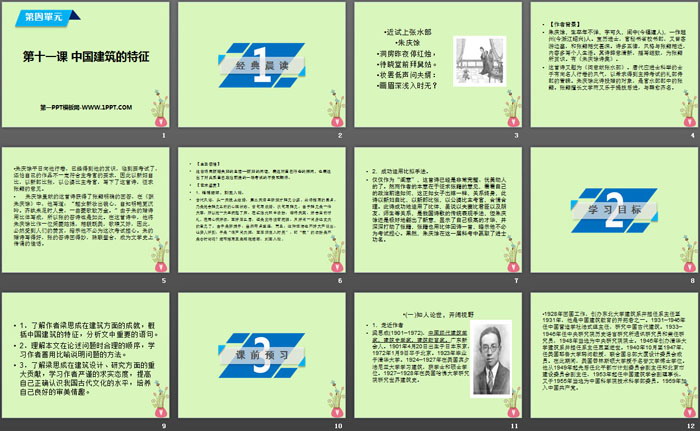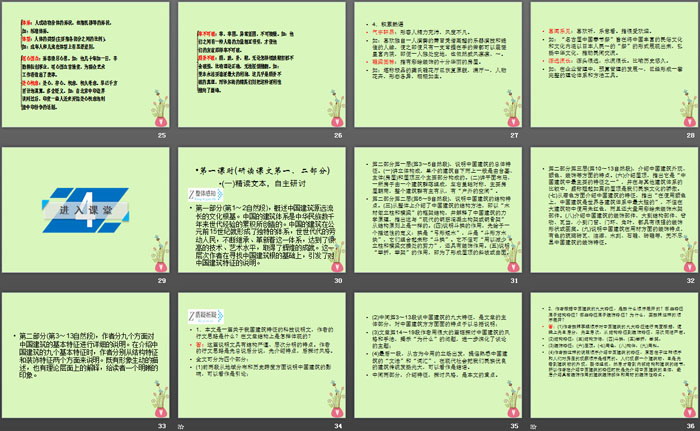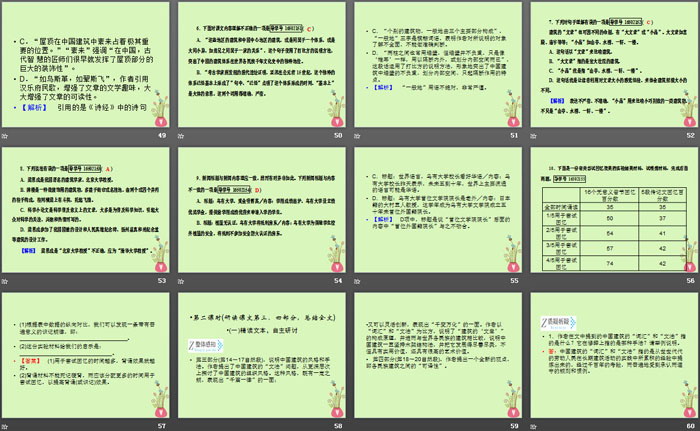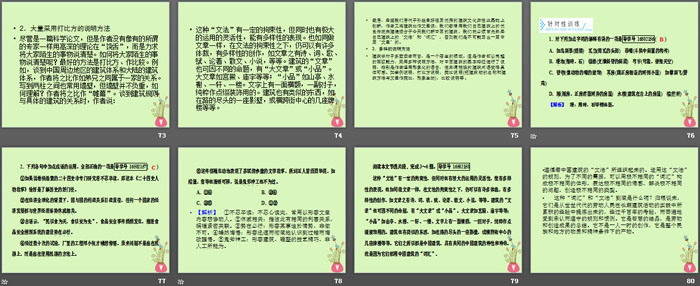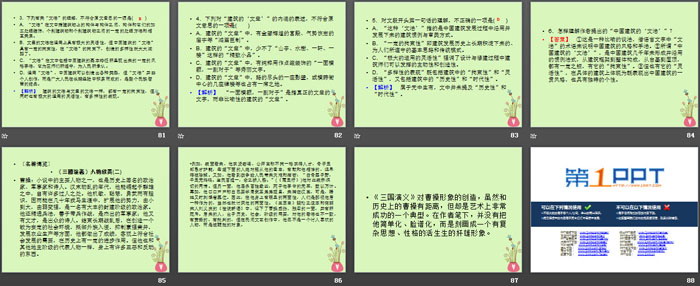
| Category | Format | Size |
|---|---|---|
| People's Education Press High School Chinese Compulsory Course Five | pptx | 6 MB |
Description
"Characteristics of Chinese Architecture" PPT
Part One: Classic morning reading
Close test on Zhang Shuibu
Zhu Qingyu
There were red candles in the bridal chamber last night.
Wait to pay homage to my uncle in front of Xiaotang.
After putting on makeup, she asked her husband in a low voice:
The eyebrows are dark and light?
【Author background】
Zhu Qingyu, whose birth and death dates are unknown, was named Kejiu. He was from Minzhong (now Fujian) and one from Yuezhou (now Shaoxing, Zhejiang). Baoli was a Jinshi, official secretary and provincial secretary. He also traveled to the frontier and had a close relationship with Zhang Ji. The poems have many five rhymes, the style is similar to Zhang Ji, and the content is mostly about personal life. His poetry was fresh in meaning and detailed in description, which was appreciated by Zhang Ji. There is "Collection of Poems by Zhu Qingyu".
This poem is also titled "Girl's Thoughts Presented to Zhang Shuibu". In the Tang Dynasty, scholars who were candidates for the Jinshi imperial examination had the custom of writing papers to famous people in the hope of gaining the favor of the Minister of Rites who presided over the examination. The recipient of Zhu Qingyu's poem was Zhang Ji, a doctor in the Ministry of Water Resources. Zhang Ji was good at literature and was willing to promote the underachievers. He was as famous as Han Yu.
Zhu Qingyu wrote papers for him on weekdays, and had already been appreciated by him. When the exam came, he was still afraid that his work might not meet the examiner's requirements, so he compared himself with the bride, the groom with Zhang, and the examiner with his parents-in-law, and wrote I read this poem and asked Zhang Ji for his opinion.
The poem presented by Zhu Qingyu received a clear answer from Zhang Ji. In "Reward Zhu Qingyu", he wrote: "The Yue girl appears in new makeup and her heart is full of beauty. She knows that she is bright and beautiful, and she is more thoughtful. Qi Wan was not rich enough when he was rich, and he sang a song. The enemy of song is ten thousand gold." Since Zhu's gift poem was written in analogy style, so was Zhang's reply poem. In this poem, he compares Zhu Qingyu to a girl named Lingcai. She is beautiful and has a good singing voice. Therefore, she must be praised by people, implying that he does not need to worry about this exam. Zhu's gift poem was well written, and Zhang's reply poem was wonderful. The perfect combination has become a good story in the history of literature.
[Perception of the theme]
This poem uses the life of a newlywed couple - the bride's questions - to express her inquiry into her own writing, and also expresses her uneasiness and expectation about an exam that is related to her political future.
【Art Appreciation】
1. Carefully crafted and detailed.
It was an ancient custom that the bride would get married the night before, and the bride would not meet her parents-in-law until early the next morning. The focus of this poem's description is her mental state before going to see him. The first sentence is about marriage, and the second sentence is about meeting. Since meeting is a big event, she got up early in the morning, dressed up in the light of red candles, and waited for dawn so that she could go to the hall to salute. After carefully putting on my makeup and drawing my eyebrows, I still felt unsure, so I had to ask my husband for his opinion. Since she was a bride, of course she was a little shy, and it was not easy to say this out loud for others to hear her, so she asked her husband in a low voice: "Through my eyebrows, the color of my eyebrows is light and dark." That is, what is "my" makeup? Isn't it fashionable? The description of details is really meticulous and meticulous.
2. Use analogies successfully.
Just as "boudoir thoughts", this poem is already very complete, beautiful and moving. However, the author's original intention is to seek Zhang Ji's opinion to see what his political future is. This is just like a woman getting married, and the relationship is lifelong. This poem compares the bride to herself, the groom to Zhang, and the parents-in-law to the examiner, which is reasonable and reasonable. This poem successfully uses analogy. Although it is a traditional expression method of Chinese poetry to compare husband and wife to monarch and minister, as well as friends, teachers and students, Zhu Qingyu still created a new meaning very well, showing his extremely high talent, and Zhang Ji was deeply moved, and Zhang Ji responded with a poem in Bi style, implying that he did not need to worry about the exam. Sure enough, Zhu Qingyu won the title of Jinshi in this scientific examination.
Characteristics of Chinese Architecture PPT, Part 2: Learning Objectives
1. Understand the author Liang Sicheng's achievements in architecture, summarize the characteristics of Chinese architecture, and analyze important sentences in the article.
2. Understand the reasonable order in which this article discusses issues, and learn the author's use of metaphors to illustrate issues.
3. Understand Liang Sicheng's major contributions in architectural design and research, learn the author's rigorous and realistic attitude, improve your ability to correctly understand ancient Chinese culture, and cultivate your good aesthetic taste.
Characteristics of Chinese Architecture PPT, Part 3: Preview before class
(1) Understand people and the world, broaden your horizons
1. Get closer to the author
Liang Sicheng (1901-1972), a modern Chinese architect, architectural historian, and architectural educator. A native of Xinhui, Guangdong. Born in Tokyo, Japan on April 20, 1901 and died in Beijing on January 9, 1972. Graduated from Tsinghua University in 1923. From 1924 to 1927, he studied architecture at the University of Pennsylvania in the United States and received bachelor's and master's degrees. From 1927 to 1928, he studied the history of world architecture at Harvard University Graduate School in the United States.
He returned to China to work in 1928, founded the Department of Architecture at Northeastern University and served as department director until 1931. He was one of the pioneers of architectural education in China. From 1931 to 1946, he served as director of the French Section of the China Architecture Society, where he studied ancient Chinese architecture. From 1933 to 1946, he served as a corresponding researcher and adjunct researcher at the Institute of History and Linguistics, Academia Sinica. In 1948, he was elected as an academician of Academia Sinica. In 1946, he founded the Department of Architecture at Tsinghua University and served as its director until his death. From October 1940 to 1947, he served as a visiting professor at Yale University and a member of the design committee of the United Nations Headquarters. During this period, Princeton University awarded him an honorary doctorate in literature. From 1949, he served as deputy director of the Peking Urban Planning Commission and deputy director of the Beijing Municipal Construction Commission. From 1953, he served as vice chairman of the Architectural Society of China. In 1955, he was elected as a member of the Department of Technology and Science of the Chinese Academy of Sciences. Joined the Communist Party of China in 1959.
2. Understand the background
Architecture is an art focused on expression. With its huge entity, architecture embodies the characteristics of the times and national style. It is a high degree of crystallization of the consciousness of a specific group. It twists and turns and vaguely integrates the rich and colorful social life into its own solid form. The great buildings in history are all faithful imprints of the times and the cultural life of the nation. The pyramids of ancient Egypt symbolized the power of the Pharaoh and the indestructibility of slavery with their huge size and strict original geometric composition; the temple architecture of ancient Greece reflected the unique harmonious and optimistic spirit and pursuit of the slave social democratic system. Perfect ideal taste; the magnificent and magnificent church buildings of the Renaissance marked the pride of the vibrant civil class.
3. Enrich your horizons
Seven Wonders of Modern Architecture in the World
(1) Itaipu Hydropower Station Located on the Parana River on the border between Brazil and Paraguay, the 8-kilometer-long Itaipu Dam blocks the world's seventh largest river and changes its flow direction. The construction of the world's largest hydropower station cost more than 18 billion U.S. dollars. The power plant is located semi-underwater. 18 hydroelectric generating units with a diameter of 16 meters are installed in the 800-meter-long factory building, with a power generation capacity of 12.6 megakilowatts.
(2) Toronto Broadcasting and Communication Tower, Canada: The 553-meter tower stands majestically and can withstand strong winds of up to 400 kilometers per hour. What is particularly worth mentioning is that it changed the traditional construction method and was built from top to bottom: a hydraulic crane raised the sliding form assembly 6 meters every day to allow concrete to roll into the lower part of the sliding form. The hoisting of the antenna on the top of the tower is unique, using a helicopter.
Characteristics of Chinese Architecture PPT, Part 4: Entering the Classroom
The first lesson (study the first and second parts of the text)
(1) Read the text intensively and conduct independent discussion
The first part (paragraphs 1 to 2) summarizes the long-standing cultural foundation of Chinese architecture. China's architectural system is created by the accumulation of experience from generation to generation of the Chinese nation over thousands of years. Chinese architecture formed a unique system in the 15th century BC. Generations of working people have continued to inherit and innovate this system, reaching high technical and artistic levels and achieving brilliant achievements. At this level, the author initiated an explanation of the characteristics of Chinese architecture based on searching for the roots of Chinese architecture.
The first level of the second part (3rd to 5th natural paragraphs) explains the overall characteristics of Chinese architecture. (1) In terms of three-dimensional composition, a single building is generally composed of three main parts: the base, the main body (house) and the roof from bottom to top. (2) Talking about the layout, a house consists of a building complex, which is axially symmetrical from left to right. The main house faces south. The entire building complex has a master and a slave, and there is "outdoor space".
The second floor of the second part (segments 6 to 9) explains the structural characteristics of Chinese architecture. (3) An overall introduction to the structural method of Chinese architecture, that is, a frame structure with "wood as columns and beams", and an explanation of the mechanical principles of Chinese architecture, pointing out that this is different from "modern reinforced concrete frames or steel skeletons" The structure is in principle the same. (4) To explain the function of Dougong, first give a descriptive definition: an arch is a "bow-shaped short wood" and a dou is a "bucket-shaped square wooden block". The combination of them is called "Dougong". It can not only "be used to reduce the shear force at the intersection of columns and beams", but also has a decorative effect. (5) Explain the function of "lifting and folding", that is, to form the slope or curved surface of the roof.
The second lesson (read the third and fourth parts of the text and summarize the full text)
(1) Read the text intensively and conduct independent discussion
The third part (paragraphs 14 to 17) explains the style and techniques of Chinese architecture. The author raises the issue of "grammar" of Chinese architecture and explores the organizational style of Chinese architecture at a deeper level. This style has certain rules and exhibits a "sameness" aspect;
It can also be flexible and innovative, showing its "ever-changing" side. The author uses "vocabulary" and "grammar" as metaphors to explain the composition principle of "architectural 'articles'", and then compares it with the architecture of various nationalities in the world, explaining that Chinese architecture has always adhered to the wooden frame structure method and developed it To be perfect, it not only has practical value, but also has high artistic value.
In the fourth part (paragraphs 18 to 20), the author puts forward a brand-new point of view, that is, the "translatability" of the architecture of various ethnic groups.
(2) Teachers give guidance and lead ideas
1. The article uses metaphors in many places. What kind of expressive effect does it have?
This article is a scientific and technological paper with rich content, which is quite representative and influential in Chinese architectural theory. However, the author did not pretend to be profound and wrote it into an obscure article, but it was concise and vivid. There are many places where metaphors are used in the article, such as: "A wall is also commonly used between two columns, but the wall is not load-bearing. It is just like a 'curtain', used to separate the inside and outside, or to divide the internal space."
Here, the author uses the common curtain as an analogy to point out the role of walls in partitioning and dividing space, and makes it clear and clear. It can be seen that using analogies can make use of the similarities between two different things to highlight the characteristics of the things and enhance the image and vividness of the explanation. At the same time, it should be pointed out that the metaphors used in natural science papers are basically the same as those used in figures of speech. The difference is that figurative rhetoric includes similes, metaphors and metonymy, while similes and metaphors are mostly used in natural science and technology papers, while metonymy is not suitable.
2. In the last paragraph of the article, "If we want to use our own fine architectural traditions to build buildings suitable for our new China today, we must first be familiar with our own architectural 'grammar' and 'vocabulary', otherwise we will not be able to Write a Chinese 'article'." What does this sentence mean?
The author points out that we must first understand the architectural style of our own nation before we can use its "grammar" and "vocabulary" to serve the architectural cause of New China.
Characteristics of Chinese Architecture PPT, Part 5: Summary Center
By introducing the nine major characteristics of Chinese architecture and the "grammar", "vocabulary" and "translatability" of architecture, this article shows us the unique charm and great value of Chinese architecture in the history of world architecture. It also points out that each architectural system has Its own "grammar" and "vocabulary", following these formulas create the richness and diversity of world architecture. At the same time, it also shows the history and culture of various countries and ethnic groups.
appreciating art
1. The writing method adopts the "three-dimensional comparison" method
If it were just a systematic summary of traditional architecture, it would already be a good article, but the author did not stop at this level. He also went one step further to compare Chinese traditional architecture with some foreign architecture. Being able to make horizontal comparisons between China and foreign countries already shows the author's rich knowledge and broad vision, but the author goes a step further and introduces literary language and its terms to compare with architectural terms, especially "grammar" and "vocabulary", which will be of great help to the general public. Architectural terms that are relatively unfamiliar to most Chinese people are transformed into literary terms that are generally familiar to everyone, allowing architecture to "walk" in front of readers. In addition, as a scientific paper, it is very important to have clear organization. The advantages of this article in terms of organization are clear at a glance. It is mainly reflected in the listing of nine characteristics. The author summarizes the basic characteristics of Chinese architecture as the following nine points, and uses serial numbers to describe the nine characteristics, which is very convenient for readers to grasp.
2. Extensive use of metaphors to explain
Although it is a scientific paper, the author does not "talk" with advanced theories like some so-called experts, but strives to explain clearly things that are unfamiliar to everyone. How to explain things clearly that are unfamiliar to everyone? The best way is to make analogies and comparisons. For example, when talking about the architectural system in the surrounding areas of China and the architectural system in the mainland, the author compares them to the relationship between brothers who belong to the same family. It is written that a wall is often used between two columns, but the wall is not load-bearing. How to understand? The author compares it to a "curtain". When talking about the relationship between building rules and specific buildings, the author said:
Characteristics of Chinese Architecture PPT, Part Six: [Masterpiece Expo]
Appreciation of Characters in "Romance of the Three Kingdoms" (2)
Cao Cao: One of the main characters in the novel, he is also a famous politician, military strategist and poet in history. In the turbulent era of the late Han Dynasty, he was able to rise among the heroes, which has many advantages. He was astute, intelligent, brave and courageous, so he was able to expand his power from small to large, from weak to strong during his decades of military career. He was an ambitious politician of the feudal class. He is also proficient in the art of war, good at leading troops in battle, and is an outstanding military strategist; he is also talented in literature and is an outstanding poet. After the long-term war ended, he made achievements in creating a relatively stable social environment, resisting foreign invasion, restraining powerful mergers, and developing agricultural production. Objectively, he met the needs of social development and made certain progress in history. effect. But like other representatives of the landlord class, he also has many ugly and reactionary things in him.
For example, on the surface, he seems to be thirsty for talents, and he publicly declares that he is seeking talents in an eclectic way, but in his heart he is jealous of talents and abilities. He hopes that the people below will absolutely obey his will. Anyone who dares to go against him will be eliminated sooner or later. . Another example is that he saw the disaster and pain that the war had brought to the people: "White bones are exposed in the wild, and there are no roosters crowing for thousands of miles. The people have lost one thing, and the thought of it is heartbreaking." ("A Walk in the Grass") He expressed deep feelings about this. of sympathy. But on the other hand, he massacred the people the most, and tens of thousands of innocent people died in his hands. For another example, he kept claiming that he wanted to learn from Ji Dan, the younger brother of King Wu of Zhou, to assist the Han Dynasty, but secretly he always wanted to usurp the throne. Therefore, there is an obvious duality in him. People despise his latter behavior, and of course they hate his duality. Pei Songzhi's annotated version of "Three Kingdoms" and "Shi Shuo Xin Yu" written by Liu Yiqing of the Southern Song Dynasty recorded Cao Cao's hypocritical and cruel side and denounced him. Later people, out of historical, social and class needs, had different views on him. Some praised and some criticized. However, in folk literature and art creation, he is no longer a lovable figure, but is criticized. Object.
Keywords: Free download of PPT courseware for high school Chinese compulsory course five from the People's Education Press, PPT download of characteristics of Chinese architecture, .PPT format;
For more information about the "Characteristics of Chinese Architecture" PPT courseware, please click the "Characteristics of Chinese Architecture" ppt tag.
"Characteristics of Chinese Architecture" PPT courseware download:
"Characteristics of Chinese Architecture" PPT courseware download part one content: Introduction to the new lesson There is a statue in the Tsinghua University Garden in Beijing, which is known as the twelfth statue in this famous university: the elegant Mr. Liang Sicheng, wearing a pair of glasses, looking straight Smiling slightly, calmly, calmly...
"Characteristics of Chinese Architecture" PPT teaching courseware:
"Characteristics of Chinese Architecture" PPT teaching courseware Part One: Introduction of new knowledge Liang Sicheng (19011972), a famous Chinese architect and professor of Tsinghua University. The main designer of the National Emblem of the People's Republic of China and the Monument to the People's Heroes. If you criticize one person by mistake, there will be many consequences...
"Characteristics of Chinese Architecture" PPT download:
"Characteristics of Chinese Architecture" PPT Download Part One: Liang Sicheng's family background, the eldest son of Liang Qichao, a famous scholar in modern times. Born in April 1901 in Tokyo, Japan. He has been deeply influenced by his father since he was a child and has laid a good foundation of Chinese culture..
File Info
Update Time: 2024-07-23
This template belongs to Chinese courseware People's Education Press High School Chinese Compulsory Course Five industry PPT template
"Characteristics of Chinese Architecture" PPT Simple campus recruitment activity planning plan summary enterprise and institution recruitment publicity lecture PPT template is a general PPT template for business post competition provided by the manuscript PPT, simple campus recruitment activity planning plan summary enterprise and institution recruitment promotion Lecture PPT template, you can edit and modify the text and pictures in the source file by downloading the source file. If you want more exquisite business PPT templates, you can come to grid resource. Doug resource PPT, massive PPT template slide material download, we only make high-quality PPT templates!
Tips: If you open the template and feel that it is not suitable for all your needs, you can search for related content "Characteristics of Chinese Architecture" PPT is enough.
How to use the Windows system template
Directly decompress the file and use it with office or wps
How to use the Mac system template
Directly decompress the file and use it Office or wps can be used
Related reading
For more detailed PPT-related tutorials and font tutorials, you can view: Click to see
How to create a high-quality technological sense PPT? 4 ways to share the bottom of the box
Notice
Do not download in WeChat, Zhihu, QQ, built-in browsers, please use mobile browsers to download! If you are a mobile phone user, please download it on your computer!
1. The manuscript PPT is only for study and reference, please delete it 24 hours after downloading.
2. If the resource involves your legitimate rights and interests, delete it immediately.
3. Contact information: service@daogebangong.com
"Characteristics of Chinese Architecture" PPT, due to usage restrictions, it is only for personal study and reference use. For commercial use, please go to the relevant official website for authorization.
(Personal non-commercial use refers to the use of this font to complete the display of personal works, including but not limited to the design of personal papers, resumes, etc.)
Preview

